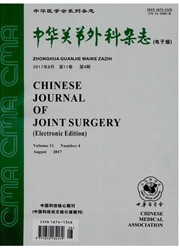

 中文摘要:
中文摘要:
目的:分析疼痛对人工膝关节表面置换术后膝关节功能康复水平的影响。方法术后3个月随访初次接受单侧膝关节表面置换手术的骨关节炎患者82例,根据患者出院后的回顾性VAS评分分为无~轻度疼痛组和中~重度疼痛组,测量患者大腿周径,与术前和术后5 d大腿周径进行对比,对比组间大腿周径增幅差值。测量膝关节屈伸活动度,与术后5d活动度对比,计算组间关节活动度增量差距。测量股四头肌肌力,与术后5d股四头肌肌力进行对比,计算组间股四头肌肌力增幅差异。测量30 m行走时间,了解疼痛程度对术后早期行走速度的影响。结果无痛~轻度疼痛组术后3个月大腿周径较术前增幅(0.94±0.95)%,显著低于中度~重度疼痛组[较术前增幅(8.03±1.99)%,P<0.01]。术后5 d两组膝关节活动度相当,无痛~轻度疼痛组术后3个月屈曲活动度增至(110.93°±12.54°),中度~重度疼痛组则减至(82.18°±12.03°)(P<0.01)。无痛~微痛组术后3个月股四头肌肌力较术后5 d增幅(117.21±22.45)%,显著高于中度~重度疼痛组[增幅(33.78±11.71)%, P <0.01]。术后3个月无痛~轻度疼痛组30 m 平地行走耗时(21.01±4.86)s,显著低于中度~重度疼痛组[耗时(29.39±6.29)s,P<0.01]。结论疼痛显著影响人工膝关节表面置换术后膝关节功能的康复水平,导致关节肿胀消退迟缓、肌力恢复延迟、关节活动度减低和行走缓慢。
 英文摘要:
英文摘要:
Objective To analysis the influence of postoperative pain on the recovery process of joint function after total knee arthroplasty ( TKA).Methods In a 3-month postoperative follow-up, 82 patients undertaken unilateral TKA with a primary diagnosis of osteoarthritis were divided into the no -mild pain group and the moderate-severe pain group according to the retrospective VAS score after the discharge.The preoperative thigh circumference was measured to compare with that of the 5th day postoperatively;the differences of the preoperative and postoperative thigh circumferences in the two groups were andlysed.The preoperative knee flexion was recorded to compared with that of the 5th day postoperatively , and the increase of the range of motion in the two groups was calculated .The preoperative muscle strength of quadriceps femoris was measured to compare with that of the 5th day postoperatively .The increase of muscle strength of quadriceps femoris was calculated between the groups .30-meter walking time was recorded to discuss the influence of the pain level on the early postoperative walking speed .Results Compar with the preoperative status , the thigh circumference in the third month postoperatively of the no-mild pain group was increased (0.94 ±0.95)%, which was significantly lower than that of the moderate-severe pain group [ the thigh circumference increased ( 8.03 ± 1.99 ) %] ( P 〈0.01 ) .The range of motion on the 5th day postoperatively showed no difference between the two groups .The knee flexion of the no-mild pain group in the third month postoperatively increased to (110.93°±12.54°), while that of the moderate-severe pain group decreased to (82.18°±12.03°) (P〈0.01).Comparing with the status on the 5th day postoperatively , the muscle strength of quadriceps femoris of the no-mild pain group in the third month postoperatively increased (117.21 ±22.45)%, which was significantly higher than that of the moderate-severe pain group [ increased ( 33.78 ±
 同期刊论文项目
同期刊论文项目
 同项目期刊论文
同项目期刊论文
 期刊信息
期刊信息
